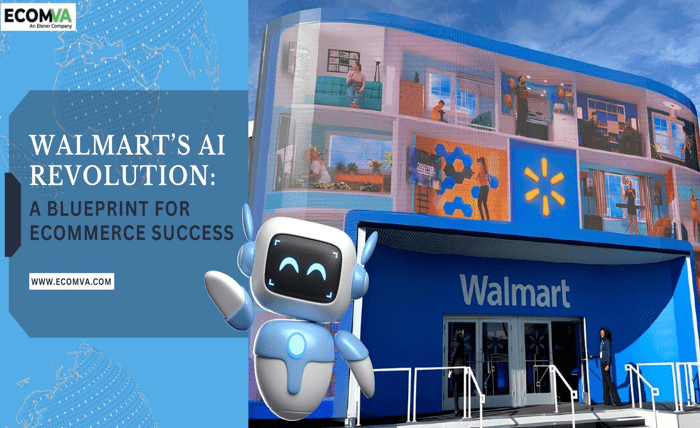
Imagine shopping online and having the exact product at your doorstep within minutes. Think beyond simple search bars — picture a retail ecosystem that even predicts what you will purchase next. This future vision is becoming reality, thanks to how Walmart Automation blends AI, robotics, and data analytics. And for Ecommerce owners and entrepreneurs, it holds lessons worth learning.
At Walmart, the AI revolution started quietly — as a solution for internal logistics — but it has evolved into a full-scale retail transformation. Now, they are setting new automation standards across global supply chains, store management, and customer experience.
For Ecommerce platforms, this might feel distant, yet it is closer than you think — and it’s reshaping how products reach shoppers, how pricing evolves, and how businesses compete online. Read on to learn further:
What Makes Walmart Automation a Game-Changer in Retail?
Walmart automation isn’t just about speed — it’s about scale. With 4,700+ stores worldwide and a network of distribution centers designed with AI at the core, they handle inventory, pricing, delivery, and even employee tasks through automation systems.
Their AI projects range from digital twins mirroring store activity to predictive analytics that anticipate demand trends. A prime example is their agentic AI model, which uses multimodal data to make decisions in real time — rather than relying solely on human direction.
As Ecommerce owners, these are the same approaches you could learn from when scaling product data entry, inventory management, and order fulfillment tasks.
How Is Walmart Using AI to Redefine Store Operations?
Inside stores, AI supports employees by predicting customer demand, mapping product placement, and even detecting products running low on shelves before they run out. These systems also create AI-powered recommendations for shoppers based on both preference data and location trends.
For Ecommerce platforms, this sets a new benchmark. By integrating AI-driven pricing (which can fluctuate with demand) and personalized recommendations, Walmart shows how automation can elevate online storefronts beyond static product listings.
You can do the same with targeted data and personalized content — incorporating search optimization and pricing strategies informed by these benchmarks.
What Role Does AI Play in Supply Chains and Logistics?
AI’s impact is most noticeable behind the scenes, in how Walmart operates its vast supply chain. They’ve transformed logistics with tools such as:
- Predictive Warehouse Systems:These determine which products should go where, when, reducing waste and delivery times.
- Self-Healing Inventory:When shelves are overstocked, AI reroutes excess goods automatically.
- Agentic Automation:Associates use AI chatbots to fix issues in seconds, not hours.
- Temperature Sensors:Walmart is deploying automated sensors to monitor the location and condition of nearly 90 million grocery pallets every year — a move aimed at boosting freshness, reducing waste, and cutting down manual work.
For Ecommerce businesses, such supply chain automation supports strategies like Walmart dropshipping automation, where products are sourced and shipped directly from suppliers without storing inventory.
Learning how Walmart did this helps you identify how rod ones can build similar systems using vendors, AI tracking, and fulfillment automation.
How Are Walmart’s AI Tools Enhancing Customer Experience?
AI is reshaping how brands interact with shoppers. Walmart’s predictive models analyze event data, weather conditions, and even regional trends to make sure inventory meets demand — often in real time. That level of insight leads to ultra-targeted promotions and smarter restocking.
It even extends to hyperpersonalization — for example, generating product suggestions based on prior searches and societal trends. Buyers now trust AI recommendations almost as much as human endorsement. And that’s a cue for Ecommerce businesses: integrating AI-powered product recommendation engines elevates conversion rates and customer satisfaction.
Use AI to analyze purchase patterns and tailor experiences — from recommendation pop-ups to pricing adjustments — and you will match the standard set by Walmart’s customers.
What’s Walmart’s Approach Toward Workforce Automation?
Automation at Walmart doesn’t mean replacing staff — it means enabling them. AI tools support store managers in shift planning, automate repetitive tasks, and even translate conversations across 44 languages, making teams more productive and adaptable.
At the same time, Walmart explores what CEO Doug McMillon called a “world where AI changes every job.”
They’re also creating roles such as agent builders, who design AI systems, and robotics coordinators, who manage ecosystem tasks. For Ecommerce owners, this illustrates a critical lesson: automation works best when supported by skilled people.
For teams scaling online storefronts, roles like Amazon FBA Specialist, PIM manager, or Walmart automation service coordinator will play an increasingly important strategic part.
How Does Walmart Automation Benefit Ecommerce Entrepreneurs?
Walmart is not just automating its own systems — they’re enabling others to emulate that efficiency. Their marketplace is open to third-party sellers, and AI agents are helping those sellers optimize listings, manage inventory, and personalize pricing in real time.
If you run an online store, this is your chance. The same sort of automation—such as Ecommerce product data entry services and Walmart store automation services—used by large retailers can also be built into your business.
AI dropshipping platforms can automatically search supplier stock levels, reroute orders, and track fulfillment, while product data entry outsourcing can help you focus on larger strategic decisions.
What Does Walmart’s AI Security Framework Look Like?
AI power does not come without risks. Walmart is acutely aware of data privacy, bias concerns, and ethical use. It maintains extensive transparency protocols, third-party audits, and data privacy safeguards, particularly around sensitive customer information.
This exposure is a warning for online store managers. Trust is a brand’s foundation today — and how you handle data is now part of your brand’s reputation. Learning from Walmart automation’s approach — combining effectiveness with compliance — offers a robust roadmap for your own security strategy.
How Does Walmart’s Super Agent Strategy Work?
Previously, Walmart had thousands of fragmented AI agents performing isolated tasks. That caused confusion, so they consolidated these into four “super agents,” each focused on key functions: customer support, merchandising, supplier assistance, and technology solutions.
This restructuring mirrors the future of automation. Instead of micro-tools, enterprises will rely on intelligent ecosystems. For Ecommerce vendors, using AI platforms with central dashboard functions — where inventory, orders, pricing, and marketing work as one — is the way forward.
What Lies in the Future for Walmart Automation?
Walmart’s roadmap includes autonomous delivery vehicles, self-driving middle-mile trucks (via Gatik), and micro-fulfillment robotics at store level. They are also deepening their partnership with OpenAI to integrate ChatGPT-powered tools across operations — from warehouse bots to sales support.
Today, their delivery times are 40% shorter than two years ago, and over 45% of orders arrive within an hour — thanks to AI optimization. The chain’s mindset? Retail isn’t about being “online only” anymore; it’s about being smartly automated across every channel.
What Does This Mean for Your Business?
As Ecommerce business owners, what can you learn from Walmart automation?
- Invest in Data Intelligence:Use predictive AI to anticipate demand, not just track past sales.
- Automate Where Free Time Matters:Outsource repetitive tasks like product data entry and online store management while you focus on growth strategies.
- Think Beyond the Transaction:AI isn’t just about making sales faster — it transforms supply chain reliability, pricing accuracy, and customer trust.
- Build for Scale:Automation should grow with your business — from Walmart automation service integration to end-to-end supply chain tracking.
FAQs
Q: Does Walmart use AI just for Ecommerce?
A: No. AI drives store operations, supply chains, workforce tasks, and product development. It touches every part of the business.
Q: Can smaller online brands use Walmart automation techniques?
A: Absolutely. Techniques like predictive analytics, digital twins, and automation platforms are scalable and available through third-party services.
Q: How is Walmart’s AI improving delivery times?
A: AI optimizes routing, predicts demand, and even directs autonomous vehicles — all of which reduce delivery times considerably.
Q: Will AI replace jobs at Walmart?
A: AI will change jobs — but new roles (like AI agents and robotics coordinators) are emerging. Overall job numbers are expected to remain stable.
Q: How can Ecommerce entrepreneurs benefit immediately?
A: You can start small — by outsourcing tasks like product data entry, inventory tracking, or pricing optimization. Gradually, you can build Walmart automated workflows using AI tools that predict trends, manage operations, and personalize customer experiences efficiently.




